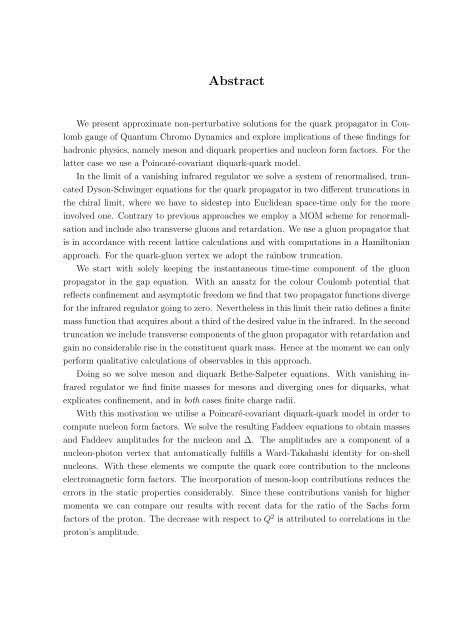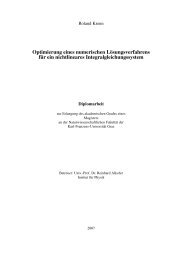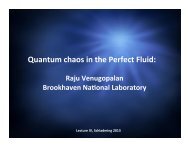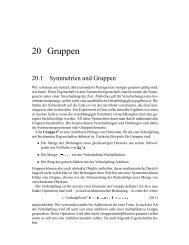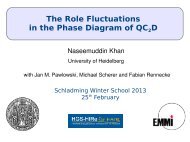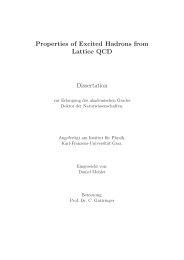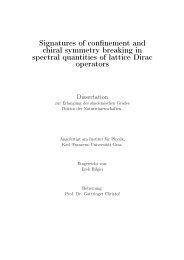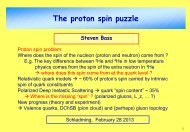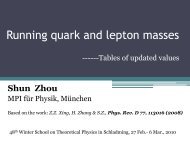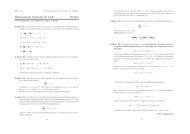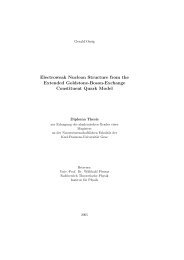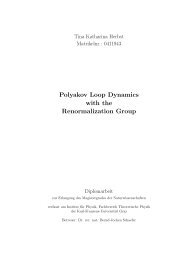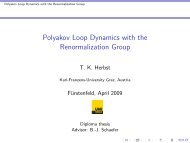The QCD Quark Propagator in Coulomb Gauge and - Institut für Physik
The QCD Quark Propagator in Coulomb Gauge and - Institut für Physik
The QCD Quark Propagator in Coulomb Gauge and - Institut für Physik
Create successful ePaper yourself
Turn your PDF publications into a flip-book with our unique Google optimized e-Paper software.
Abstract<br />
We present approximate non-perturbative solutions for the quark propagator <strong>in</strong> <strong>Coulomb</strong><br />
gauge of Quantum Chromo Dynamics <strong>and</strong> explore implications of these f<strong>in</strong>d<strong>in</strong>gs for<br />
hadronic physics, namely meson <strong>and</strong> diquark properties <strong>and</strong> nucleon form factors. For the<br />
latter case we use a Po<strong>in</strong>caré-covariant diquark-quark model.<br />
In the limit of a vanish<strong>in</strong>g <strong>in</strong>frared regulator we solve a system of renormalised, truncated<br />
Dyson-Schw<strong>in</strong>ger equations for the quark propagator <strong>in</strong> two different truncations <strong>in</strong><br />
the chiral limit, where we have to sidestep <strong>in</strong>to Euclidean space-time only for the more<br />
<strong>in</strong>volved one. Contrary to previous approaches we employ a MOM scheme for renormalisation<br />
<strong>and</strong> <strong>in</strong>clude also transverse gluons <strong>and</strong> retardation. We use a gluon propagator that<br />
is <strong>in</strong> accordance with recent lattice calculations <strong>and</strong> with computations <strong>in</strong> a Hamiltonian<br />
approach. For the quark-gluon vertex we adopt the ra<strong>in</strong>bow truncation.<br />
We start with solely keep<strong>in</strong>g the <strong>in</strong>stantaneous time-time component of the gluon<br />
propagator <strong>in</strong> the gap equation. With an ansatz for the colour <strong>Coulomb</strong> potential that<br />
reflects conf<strong>in</strong>ement <strong>and</strong> asymptotic freedom we f<strong>in</strong>d that two propagator functions diverge<br />
for the <strong>in</strong>frared regulator go<strong>in</strong>g to zero. Nevertheless <strong>in</strong> this limit their ratio def<strong>in</strong>es a f<strong>in</strong>ite<br />
mass function that acquires about a third of the desired value <strong>in</strong> the <strong>in</strong>frared. In the second<br />
truncation we <strong>in</strong>clude transverse components of the gluon propagator with retardation <strong>and</strong><br />
ga<strong>in</strong> no considerable rise <strong>in</strong> the constituent quark mass. Hence at the moment we can only<br />
perform qualitative calculations of observables <strong>in</strong> this approach.<br />
Do<strong>in</strong>g so we solve meson <strong>and</strong> diquark Bethe-Salpeter equations. With vanish<strong>in</strong>g <strong>in</strong>frared<br />
regulator we f<strong>in</strong>d f<strong>in</strong>ite masses for mesons <strong>and</strong> diverg<strong>in</strong>g ones for diquarks, what<br />
explicates conf<strong>in</strong>ement, <strong>and</strong> <strong>in</strong> both cases f<strong>in</strong>ite charge radii.<br />
With this motivation we utilise a Po<strong>in</strong>caré-covariant diquark-quark model <strong>in</strong> order to<br />
compute nucleon form factors. We solve the result<strong>in</strong>g Faddeev equations to obta<strong>in</strong> masses<br />
<strong>and</strong> Faddeev amplitudes for the nucleon <strong>and</strong> ∆. <strong>The</strong> amplitudes are a component of a<br />
nucleon-photon vertex that automatically fulfills a Ward-Takahashi identity for on-shell<br />
nucleons. With these elements we compute the quark core contribution to the nucleons<br />
electromagnetic form factors. <strong>The</strong> <strong>in</strong>corporation of meson-loop contributions reduces the<br />
errors <strong>in</strong> the static properties considerably. S<strong>in</strong>ce these contributions vanish for higher<br />
momenta we can compare our results with recent data for the ratio of the Sachs form<br />
factors of the proton. <strong>The</strong> decrease with respect to Q 2 is attributed to correlations <strong>in</strong> the<br />
proton’s amplitude.


